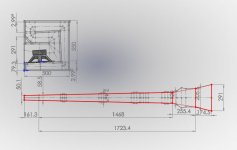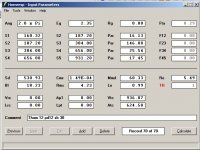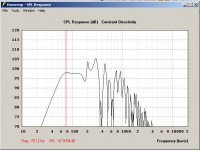If going with the THAM 12, I suggest paying a lot of attention to the bracing in the first fold. Don't do like what I did with my THAM12 lookalike and think you can get away with making the external panel removable and mount the driver through the hole. Two layers of 3/4 ply AND metal bracing inside and that panel STILL vibrates, enough to toss one of my tops off of it when I turned the bass up during the last "war volume" test.
So I'm not exactly following which panel that you're talking about, do you have pictures?
Which reminds me of another advantage to THs that don't show up in the sims - all that wonderful free side-panel bracing that comes as a result of folding a horn into a box.
Yes, I alluded to that earlier. My impression is that's part of the construction advantage of TH designs.
I wonder why MLTLs are not being considered?
I don't know anything about them.
So I'm not exactly following which panel that you're talking about, do you have pictures?
It's the external panel that the driver faces.
You can see pictures of my POC TH at this link: The Subwoofer DIY Page v1.1 - Projects : "Proof of Concept #2"
If I was doing this again, that top panel would not be removable - it would be cross-braced to the panel that's holding the driver.
MLTLs are basically TLs that are terminated by a vent. You can model them (raw response) in HornResp.
Hi ghettosynth,
One form of the bracing Brian is talking about can be seen in the picture on Anders Martinsson's Blog: Martinsson's Blog - THAM12
By the way, if you want to reinforce this area, the cone correction talked about in the Xoc1 TH-18 thread would be applicable, or you could bifurcate the section to the first right angle corner (fold the duct back on itself).
Regards,
One form of the bracing Brian is talking about can be seen in the picture on Anders Martinsson's Blog: Martinsson's Blog - THAM12
By the way, if you want to reinforce this area, the cone correction talked about in the Xoc1 TH-18 thread would be applicable, or you could bifurcate the section to the first right angle corner (fold the duct back on itself).
Regards,
Out of context my comment probably appears to make no sense, of course hornresp designs consider the dimensions of the cabinet, however, only as a consequence of the dimensions of the unfolded horn. In other words, the cabinet dimensions proper that are not a function of the unfolded horn dimensions are of no concern to the model. Please see my comment a few pages ago regarding the THAM12 design. If one increases the height of the cabinet, holding all other areas constant, then one only changes a single variable in the hornresp design. Experimenting with this it seems that I gain some low end extension by increasing cabinet height allowing for a longer horn, but get diminishing returns beyond 3 to 4 inches. My question was not whether or not this is true, it is, rather, it's whether or not I was overlooking anything else. In other words, it appears to me that my modification would adapt the design more to my liking without compromising any aspect of the fold.
Hi ghettosynth,
Many thanks for the detailed explanation - now I understand
Kind regards,
David
I'm actually in the making of a couple of THAM12s at the moment.
(i know .. MDF .. but i am trying to achieve some kind of cheap boxes and ply is rather expensive where i live)
Hopefully i will have both done and tested in the weekend. Will post my findings.
I have also build four SS15s, but they got too big for my needs, so now i'm trying these small 12" boxes. My choice was also between MTH30 and THAM12, so i'm very excited to hear how they perform. They will be loaded with PD 12SB30.
An externally hosted image should be here but it was not working when we last tested it.
(i know .. MDF .. but i am trying to achieve some kind of cheap boxes and ply is rather expensive where i live)
Hopefully i will have both done and tested in the weekend. Will post my findings.
I have also build four SS15s, but they got too big for my needs, so now i'm trying these small 12" boxes. My choice was also between MTH30 and THAM12, so i'm very excited to hear how they perform. They will be loaded with PD 12SB30.
Last edited:
It's the external panel that the driver faces.
You can see pictures of my POC TH at this link: The Subwoofer DIY Page v1.1 - Projects : "Proof of Concept #2"
If I was doing this again, that top panel would not be removable - it would be cross-braced to the panel that's holding the driver.
Great, tnx for the link. After I posted, I guessed what you meant, but the pictures were very informative. In particular, other than the first section of the horn, your horn tapers are stepped, yet, your sim is in good agreement with your measured response, suggesting that horn taper isn't that critical either.
Does anyone have any insight from this from the theory?
At the frequencies the TH is working at, a stepped taper compared to a smooth taper makes little difference.In particular, other than the first section of the horn, your horn tapers are stepped, yet, your sim is in good agreement with your measured response, suggesting that horn taper isn't that critical either.
Does anyone have any insight from this from the theory?
A 100 Hz wave is 11.3 feet long, a 50 Hz wave 22.6 feet, small changes in the shape have little effect, while restricting cross section may have fairly large effects.
Also of note is floppy panels reduce upper bass more than low frequencies, stiffness is needed for punch, and the throat area is the place where pressure minimum and maximum is greatest, a loose panel there makes more difference than any other part of the cabinet.
Last edited:
The Tham 12 is tiny.
On Martinsons blog the Tham12 is shown with a sim of over 88 litres
This is despite the actual internal volume being 74.3 litres without any bracing or driver!
The path length is also shorter than shown on the blog.
With the PD 12SB 30 I would expect 98db at 75hz in a 2pi sim
Have not unfolded the MTH30 yet!
Regards
Xoc1
On Martinsons blog the Tham12 is shown with a sim of over 88 litres
This is despite the actual internal volume being 74.3 litres without any bracing or driver!
The path length is also shorter than shown on the blog.
With the PD 12SB 30 I would expect 98db at 75hz in a 2pi sim
Have not unfolded the MTH30 yet!
Regards
Xoc1
Attachments
Also of note is floppy panels reduce upper bass more than low frequencies, stiffness is needed for punch, and the throat area is the place where pressure minimum and maximum is greatest, a loose panel there makes more difference than any other part of the cabinet.
Yep. In fact, if I was building the THAM12 at this point, I'd be using two braces rather than one in the first section, just to ensure that section is as stiff as possible.
A comparison of the impedance vs. frequency measurement on the built sub should show if it's built stiff enough (if it's not, the upper impedance peaks will be degraded and maybe even non-existant). See The Subwoofer DIY Page v1.1 - Projects : Using Impedance Graphs
The Tham 12 is tiny.
On Martinsons blog the Tham12 is shown with a sim of over 88 litres
This is despite the actual internal volume being 74.3 litres without any bracing or driver!
The path length is also shorter than shown on the blog.
With the PD 12SB 30 I would expect 98db at 75hz in a 2pi sim
Have not unfolded the MTH30 yet!
Regards
Xoc1
Ah, that might explain the difference. I haven't seen any measurements of actual THAM12 builds, only variations on the design similar to what I've discussed.
Hi Xoc1,On Martinsons blog the Tham12 is shown with a sim of over 88 litres. This is despite the actual internal volume being 74.3 litres without any bracing or driver!The path length is also shorter than shown on the blog.
With the PD 12SB 30 I would expect 98db at 75hz in a 2pi sim.
I agree with your model. Based on measurements of the Tham12 I found on another forum I made a re-model. The measurement was done with a 18Sound 12LW1400 driver which I used to re-model it.
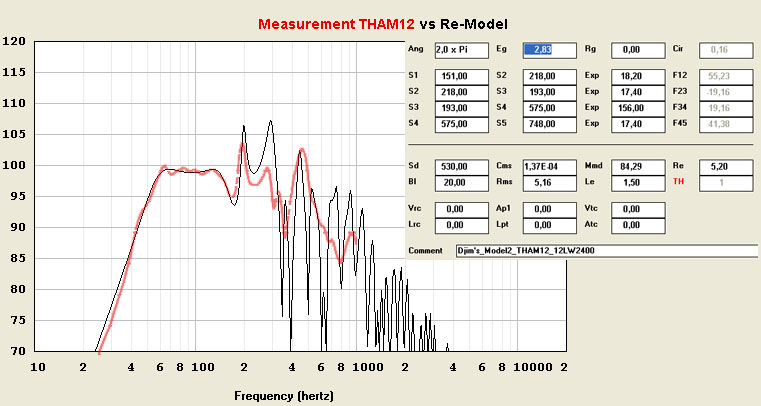
If you use the input of the old version of the PD.12SB30:
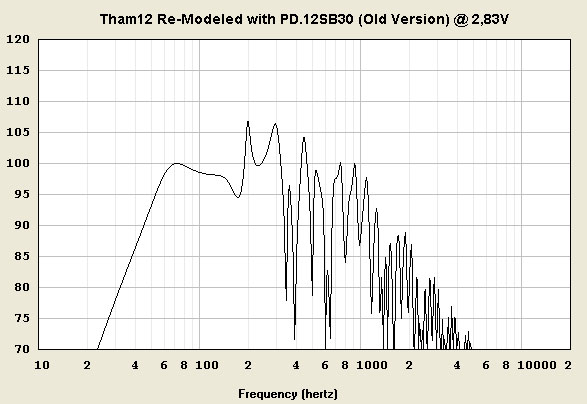
And for the newer version of the PD.12SB30;
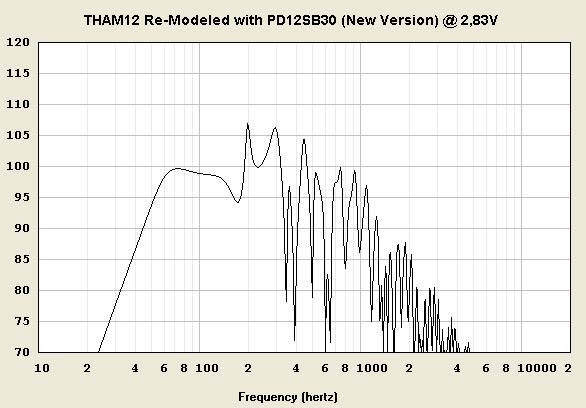
Last edited:
Hi Oliver,Would the cone correction (throat correction) be applicable to the Tham series of THs?
Now I have re-modelled the Tham12 I can show, by decreasing S2 (Cone-Volume-Correction), how it improves the dip.
For those (some Swedish members
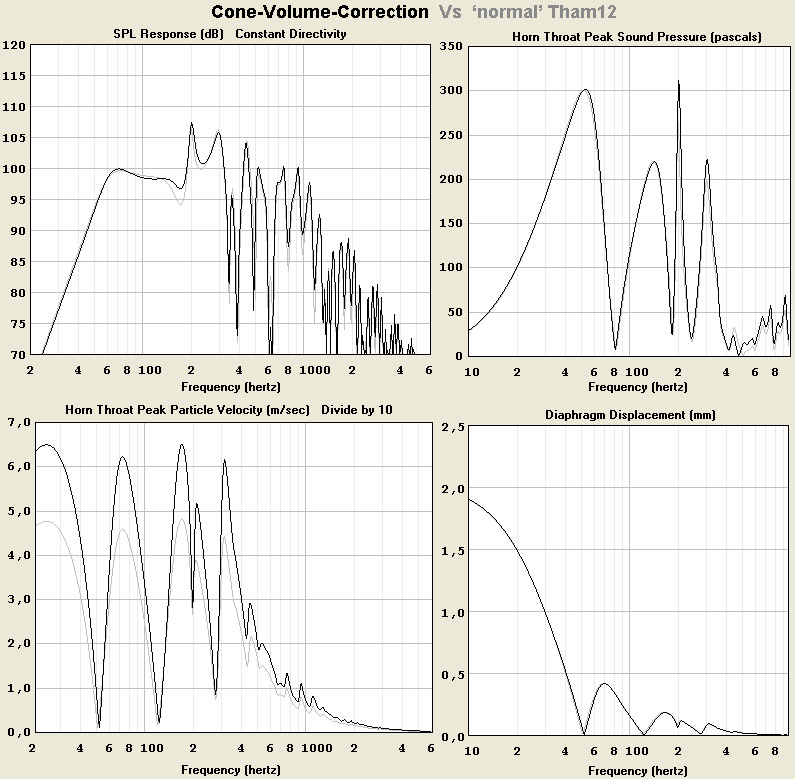
Last edited:
The Tham 12 is tiny.
On Martinsons blog the Tham12 is shown with a sim of over 88 litres
This is despite the actual internal volume being 74.3 litres without any bracing or driver!
The path length is also shorter than shown on the blog.
With the PD 12SB 30 I would expect 98db at 75hz in a 2pi sim
Have not unfolded the MTH30 yet!
Regards
Xoc1
As i am not (yet) i hornresp user, can you explain to me why you are simming with Eg: 2.35 opposed to Eg: 2.83? Isn't this the applied voltage?
As i am not (yet) i hornresp user, can you explain to me why you are simming with Eg: 2.35 opposed to Eg: 2.83? Isn't this the applied voltage?
Hi Chaps,
Perhaps Xoc1 wanted 1 watt into a nominal load impedance of 5.49 ohms (the value specified for Re) rather than into the standard 8 ohms.
Kind regards,
David
Hi Chaps,
Perhaps Xoc1 wanted 1 watt into a nominal load impedance of 5.49 ohms (the value specified for Re) rather than into the standard 8 ohms.
Kind regards,
David
Ahh i see.
Maybe i have to read a bit about the difference af nominal/minimum impedance and Re.
Just thought people always simmed with 2.83V on a (nominal) 8 ohm speaker.
Will the sim be more "real-world" when using Re?
Last edited:
Will the sim be more "real-world" when using Re?
Hi Chaps,
All it means is that for whatever reason, the simulation has been done using a constant input voltage of 2.35 volts rather than 2.83 volts. The SPL and diaphragm displacement values will be marginally less than those achieved using 2.83 volts, but this is the only impact on the results. Xoc1 may perhaps care to comment on the reason for using 2.35 volts rather than the generally accepted standard of 2.83 volts (which delivers 1 watt into an 8 ohm load).
Kind regards,
David
Last edited:
Hi Chaps,
All it means is that for whatever reason, the simulation has been done using a constant input voltage of 2.35 volts rather than 2.83 volts. The SPL and diaphragm displacement values will be marginally less than those achieved using 2.83 volts, but this is the only impact on the results. Xoc1 may perhaps care to comment on the reason for using 2.35 volts rather than the generally accepted standard of 2.83 volts (which delivers 1 watt into an 8 ohm load).
Kind regards,
David
Technically this is what is known as a late night session cockup
Regards Xoc1
Hi Oliver,
Now I have re-modelled the Tham12 I can show, by decreasing S2 (Cone-Volume-Correction), how it improves the dip.
For those (some Swedish members) who assume that cone-volume-correction adds significant compression to the system, please take a good look at the pressure and velocity models! Like the model shows, cone-volume-correction has no significant effect on pressure while it only increases velocity! In my view, this also shows why Danley 'gets away' with his V-stub without adding too much compression.

That sim'd FR suggests that the mouth isn't large enough.
Technically this is what is known as a late night session cockup
Regards Xoc1
That makes good sense to me
Guessing that will make it go around 1.5dB up from the approx. 98dBs (from your sim)
- Home
- Loudspeakers
- Subwoofers
- MTH30 Questions : Complete Noob!
